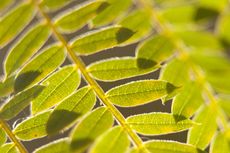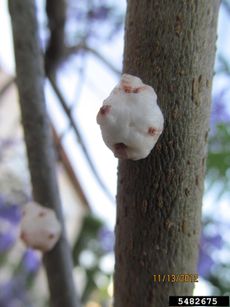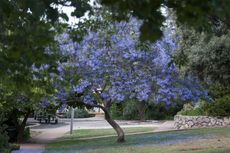Jacaranda Tree Information - How To Grow A Jacaranda Tree

The first time someone sees a jacaranda tree (Jacaranda mimosifolia), they may think they've spied something out of a fairy tale. This lovely tree often spans the width of a front yard, and is covered in beautiful lavender purple blooms every spring. Read on to learn how to grow a jacaranda tree if you have the right environment. Growing jacaranda trees is mostly a matter of having the right environment, as they're strictly southern trees that thrive in Florida and parts of Texas and California. Gardeners living further north often have success growing jacaranda as a large houseplant and they have been known to make spectacular bonsai specimens.
Jacaranda Tree Information
Jacarandas are true southern trees, thriving in USDA plant hardiness zones 9b through 11. Jacaranda tree hardiness is tested when the temperature drops below 15 degrees F. (-9 C.), and they do best above the freezing point. They prefer a sandy soil with great drainage, and show off their lavender blooms best when planted in full sun. They grow relatively fast and will get up to 60 feet tall (18 m.) and just as wide. The spreading branches may fill your entire front yard.
How to Plant and Care for a Jacaranda Tree
Choose the spot for your tree wisely. One piece of jacaranda tree information that many nurseries and catalogs don't share is that when the flowers drop, they cover the ground in a thick layer and must be raked up before they decompose into slime. An afternoon with a rake will do the trick, but this is the reason so many jacarandas are planted as street trees, allowing most of the spent blooms to fall on the street instead of in the yard. Plant the tree in an open spot with sandy soil and full sun. Keep the soil moist deep down by soaking it with a hose for half an hour, but letting it dry out in between waterings. Care for a jacaranda tree almost always includes pruning. In order to give it the best shape to show off those blooms, smaller branches should be trimmed early in the spring. Clip off suckers that grow vertically and keep one main trunk with some major branches leading off from the middle. Keep excess branches cut, to prevent the weight of the tree from splitting the trunk.
Gardening tips, videos, info and more delivered right to your inbox!
Sign up for the Gardening Know How newsletter today and receive a free download of our most popular eBook "How to Grow Delicious Tomatoes."
-
 Urban Beekeeping Guide: Top Tips For Raising Bees In The City
Urban Beekeeping Guide: Top Tips For Raising Bees In The CityUrban beekeeping can be a rewarding and appreciated pastime, but first be sure it’s legal in your city and learn the ropes of beekeeping.
By Mary Ellen Ellis
-
 2024 Plant Of The Year: Why Experts Say Philodendron Is The “It” Plant Of The Year
2024 Plant Of The Year: Why Experts Say Philodendron Is The “It” Plant Of The YearWe aren’t surprised that philodendron was designated the plant of the year. Versatile, easy-care and lovely, it’s the houseplant of the year 2024!
By Bonnie L. Grant
-
 My Jacaranda Has Yellow Leaves – Reasons For Yellowing Jacaranda Trees
My Jacaranda Has Yellow Leaves – Reasons For Yellowing Jacaranda TreesIf you have a jacaranda tree that has yellow leaves, you’ve come to the right spot. There are a few reasons for a yellowing jacaranda. Click on the following article to find out what to do about a jacaranda turning yellow.
By Amy Grant
-
 Potted Jacaranda Trees – How To Grow Jacaranda In A Pot
Potted Jacaranda Trees – How To Grow Jacaranda In A PotJacaranda has become a popular ornamental tree in tropical or semi-tropical regions. In cooler zones, potted jacaranda trees can adorn porches or patios when taken indoors through the winter. Click this article to learn more about growing jacaranda in a container.
By Darcy Larum
-
 Jacaranda Tree Not Blooming: Tips On Making A Jacaranda Bloom
Jacaranda Tree Not Blooming: Tips On Making A Jacaranda BloomJacarandas can be fickle trees, and making a jacaranda bloom can be a challenge. Even a tree that has bloomed abundantly in past years may fail to bloom. If you are wondering how to get a jacaranda to bloom, this article will tell you what you need to know.
By Ilana Goldowitz Jimenez
-
 Troubleshooting Jacaranda Tree Problems: Caring For Ailing Jacaranda Trees
Troubleshooting Jacaranda Tree Problems: Caring For Ailing Jacaranda TreesThe jacaranda is a tree you don't forget easily. But even beautiful trees can have problems, and you will sometimes see ailing jacaranda trees. Click this article for information about problems with jacaranda trees.
By Teo Spengler
-
 Jacaranda Pruning: Tips For Pruning A Jacaranda Tree
Jacaranda Pruning: Tips For Pruning A Jacaranda TreeProper pruning is vital for the healthy development of all trees, but it is especially important for jacarandas because of their rapid growth rate. This article tells you how to encourage strong, healthy growth through good pruning techniques.
By Jackie Carroll